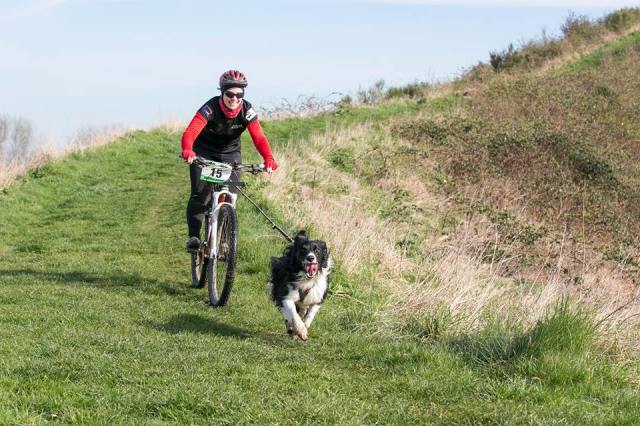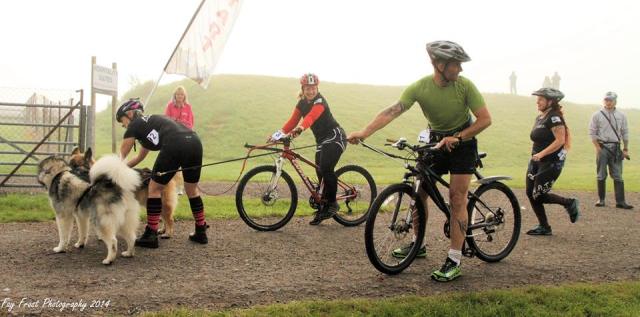Many people who come into the dog sports begin with canicross because it is the easiest way to exercise your dog and also the simplest way to train your dog to pull in a harness. However, if you’ve ever attended a race which has the bikejor classes too, then you’ll have seen how much fun the competitors have at the faster speeds you can achieve with the wheels. It doesn’t appeal to everyone but once you’ve trained your dog to pull you, it can be very tempting to have a go at either bikejor or dog scootering to get that extra speed for a more exciting run.

If you are thinking of giving bikejor a go then there are a few things you should know which will help you get the best from your experience.
The first thing you need to make sure of is that you have trained strong voice commands. When canicrossing it is easy to correct your dogs’ direction and quickly grab your bungee line to prevent any mishaps. However when you are on a bike there is no option to do this, so your dog must respond to your voice signals for directions and control otherwise you could end up causing an accident if your dog isn’t listening to you.

You also need to make sure the equipment you are using is suitable, don’t be tempted to ‘botch’ it with home made bikejor arms and lines. There are plenty of clubs now who may have equipment they can loan you to have a go with your dog and there are a small number of businesses offering training for the dog sports now. If you choose to borrow club equipment remember they are not liable for anything you do and might not be able to offer the ‘training’ you require but using the correct equipment will at least give you an idea if you’d like to do more bikejoring, so you can get your own kit to use later on.

We would suggest that it is quite important that you train solo on the bike first before attaching your dog. You might already be a skilled mountain biker and in this case you will be giving your dog the best chance of doing well at bikejoring by being in control of the bike and yourself first. However if you’re getting on a bike for the first time in a number of years (which was the situation we were in) then it is worth hitting the trails without your dog to gain some bike skills that you can utilise when you do attach your dog. Without having a basic skill level on a mountain bike you could be putting yourself and your dog at risk of harm, so just get used to being on a bike again and then you can help your dog get the best possible start to bikejoring.

It can be very helpful to find someone knowledgable to help you get started, we mentioned above there are a few businesses offering training now and some clubs also offer training weekends and camps which can be a great way to introduce your dog to something new. We recommend that you never try bikejoring first on your own, always take someone along with you who knows you and your dog just in case something unforeseen happens. Bikejoring can be great fun but always make sure someone knows where you are as accidents can happen in the most unexpected circumstances!

It is also worth educating yourself on the rules regarding insurance and rights of way when bikejoring. Many Forestry Commission sites require permits to be obtained for anything where a dog is attached to a ‘wheeled vehicle’ and the public liability insurance required to obtain a permit is £5 million. This might seem excessive but in a blame culture it is worth checking what you are covered for with your dog, as hitting into a person or another dog with your bike could be costly. Riding on roads is not permitted at all with a dog attached and it’s not good for a dogs’ joints anyway to be moving at speed on hard surfaces. With canicross a few road sections won’t do any harm but long stretches on tarmac at the higher speeds you can achieve on a bike can damage your dogs’ pads and joints.
Your dog might have been canicrossing for years and covered many miles with you on foot but always start bikejoring with short sections, to allow your dog to get used to the increase in speed. Too many people seem to think that because they can run 10 miles canicrossing they can go straight out and ride 5 miles with their dog on the bike. Being able to run at full pelt attached to a bike is a very different experience for your dog, so make sure you are not challenging your dog to begin with and keep it fun for them, leaving them wanting to do more.

If you want to know more about making the transition from canicross to bikejor we have a few recommendations for businesses, clubs and individuals who could potentially help so get in touch if you’d like to know more but we hope you’ve found this blog helpful as a guide on how to make the experience the best it can be for both you and your dog. Happy trails!


I’m now in a position to get a dog again. Can’t wait to combine my love of dogs with my love of running and mountain biking. Keep up the posts. They’re informative and motivate me 🙂